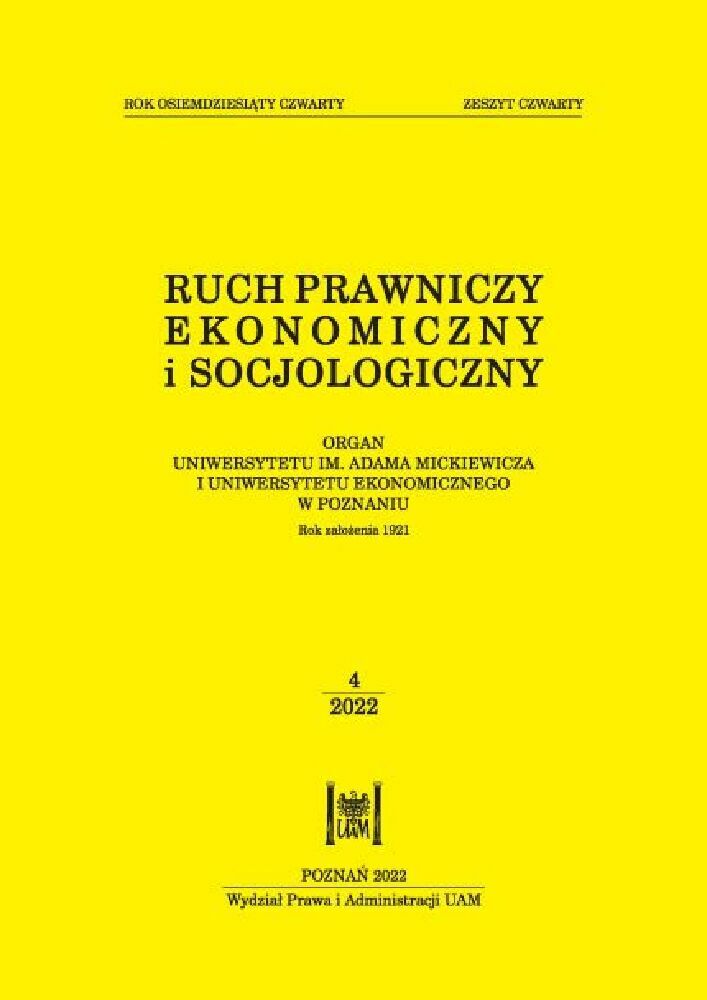Abstrakt
W Izraelu istnieje duża liczba i szeroki zakres pozarządowych organizacji wolontariackich działających w różnych obszarach. Jednocześnie, ze względu na mnogość incydentów bezpieczeństwa i innych kryzysów wewnętrznych, istnieje również wiele niezależnych inicjatyw wolontariackich powstających w ramach konkretnych społeczności, małych społeczności lub miast. Prywatne inicjatywy, które zaczynały jako niewielka pomoc wolontariuszy, rozrosły się głównie dzięki możliwościom technologicznym, które umożliwiają przekazywanie informacji o kryzysie i potrzebach z nim związanych. Niniejsze opracowanie bada postrzeganie przez wolontariuszy skuteczności w samoorganizującym się spontanicznie otoczeniu oraz ich poczucie przynależności do społeczności i państwa Izrael. W artykule przedstawiono studium przypadku niezorganizowanej, spontanicznej aktywności wolontariuszy w Izraelu w sytuacjach stresu i kryzysu. Badanie oparte jest na obserwacji uczestniczącej i półstrukturalnych wywiadach z osobami, które zaangażowały się w spontaniczną, samoorganizującą się działalność wolontariacką. Wyniki badania pokazują, że mobilizowanie wolontariuszy poprzez wiadomości WhatsApp wzmacniało poczucie skuteczności w wykonywaniu zadania, wzmacniało poczucie przynależności wolontariuszy do ich społeczności i przyczyniało się do szybkiej realizacji zadania. Badanie podkreśla również wymiary społeczno-moralne, które intensyfikują się w takim procesie wolontariatu oraz odczucia jednostki dotyczące jej miejsca w społeczeństwie i jej obserwacji zachowań społeczeństwa w ogóle.
Bibliografia
Adger, W.N. (2003). Social capital, collective action, and adaptation to climate change. Economic Geography 79: 387-404. doi: https://doi.org/10.1111/j.1944-8287.2003.tb00220.x DOI: https://doi.org/10.1111/j.1944-8287.2003.tb00220.x
Aldrich, P.D. (2012). Building Resilience: Social Capital in Post-Disaster Recovery. Chicago: University of Chicago Press. doi: https://doi.org/10.7208/chicago/9780226012896.001.0001 DOI: https://doi.org/10.7208/chicago/9780226012896.001.0001
Aldrich, D.P., Meyer, M.A. (2014). Social capital and community resilience. American Behavioral Scientist 59(2): 254-269. doi: https://doi.org/10.1177/0002764214550299 DOI: https://doi.org/10.1177/0002764214550299
Alperson, B., Dobi, T., Starkman, D. (2016). Being citizens of Israel in a Jewish and democratic state (Hebrew). Ministry of Education.
Aronson, E., Aronson, J. (2012). The Social Animal. 11th edn. New York: Worth Publishers.
Barsky, L.E., Trainor, J.E., Torres, M.R., Aguirre, B.E. (2007). Managing volunteers: FEMA's Urban Search and Rescue programme and interactions with unaffiliated responders in disaster response. Disasters 31(4): 495-507. doi: https://doi.org/10.1111/j.1467-7717.2007.01021.x DOI: https://doi.org/10.1111/j.1467-7717.2007.01021.x
Clizbe, J.A. (2004). Challenges in managing volunteers during bioterrorism response. Biosecurity and Bioterrorism: Biodefense Strategy, Practice, and Science 2(4): 294-300. doi: https://doi.org/10.1089/bsp.2004.2.294 DOI: https://doi.org/10.1089/bsp.2004.2.294
Eshet, Y., Lev, Y. (2011). Civilians' coping with war adversities - social capital and social resilience (Hebrew). Social Issues in Israel 11: 145-158. <https://www.jstor.org/stable/23389244?-seq=1>
Gianni, R. (2021). Solidarity, Resilience and cooperation in a time of a pandemic: co-designing a brighter future. BISS, Maastrich University. <https://www.biss-institute.com/blog/solidarity-resilience-and-cooperation-in-a-time-of-a-pandemic-co-designing-a-brighter-future/>.
Haski-Leventhal, D., Cnaan, R.A. (2009). Group processes and volunteering: using groups to enhance volunteerism. Administration in Social Work 33(1): 61-80. doi: https://doi.org/10.1080/03643100802508635 DOI: https://doi.org/10.1080/03643100802508635
Hustinx, L., Cnaan, R.A., Handyj, F. (2010). Navigating theories of volunteering: a hybrid map for a complex phenomenon. Journal for the Theory of Social Behaviour 40(4): 410-434. doi: https://doi.org/10.1111/j.1468-5914.2010.00439.x DOI: https://doi.org/10.1111/j.1468-5914.2010.00439.x
Johansson, R. (2013). Professional emergency responders and unorganized volunteers: incident sites as meeting places. RCR Risk and Crisis Research Center, 2. .
Manju, R. (2019). Social media activism: its impact on real life. <https://www.researchgate.net/publication/331438569_social_media_activism_its_impact_on_real_life>.
Naparstek, A.J., Dooley, D., Smith, R. (1997). Community Building in Public Housing: Ties That Bind People and Their Communities Washington D.C. U.S. Department of Housing and Urban Development. The Urban Institute/Aspen System Corporation.
Parsons, T. (2013). The Social System (B.S. Turner, ed.). Routledge Sociology Classics. <http://idr.uin-antasari.ac.id/471/1/talcotPARSON.pdf>., doi: https://doi.org/10.4324/9780203992951 DOI: https://doi.org/10.4324/9780203992951
Pfefferbaum, L.R., Pfefferbaum, B., van Horn, L.R., Klomp, R.W., Norris, H.F., Reissman, D.B. (2013). The communities advancing resilience toolkit: an intervention to build community resilience to disasters. Journal of Public Health Management and Practice 19(3): 250-258. doi: https://doi.org/10.1097/PHH.0b013e318268aed8 DOI: https://doi.org/10.1097/PHH.0b013e318268aed8
Putnam, D.R. (1993). Making Democracy Work: Civic Traditions in Modern Italy. Princeton: Princeton University Press. doi: https://doi.org/10.1515/9781400820740 DOI: https://doi.org/10.1515/9781400820740
Quarantelli, E.L. (1997). Ten criteria for evaluating the management of community disasters. Disasters, 21(1): 39-56. doi: https://doi.org/10.1111/1467-7717.00043 DOI: https://doi.org/10.1111/1467-7717.00043
Ridder, H.-G. (2017). The theory contribution of case study research designs. Business Research 10: 281-305. doi: https://doi.org/10.1007/s40685-017-0045-z DOI: https://doi.org/10.1007/s40685-017-0045-z
Shirky, C. (2011). The political power of social media: technology, the public sphere, and political change. Foreign Affairs 90(1): 28-41. doi:10.2/JQUERY.MIN.JS
Sorek, I. (2015). Solidarity (Hebrew). Lex-Key 3(1): 24-25.
Stallings, R.A., Quarantelli, E.L. (1985). Emergent citizen groups and emergency management. Public Administration Review 45: 93-100. doi: https://doi.org/10.2307/3135003 DOI: https://doi.org/10.2307/3135003
Thomas, E.F., Smith, L.G.E., Spears, R., Mcgarty, C. (2018). The role of social media in shaping solidarity and compassion fade: how the death of a child turned apathy into action but distress took it away. Researchgate.Net 20(10): 3778-3798. doi: https://doi.org/10.1177/1461444818760819 DOI: https://doi.org/10.1177/1461444818760819
Yin, R.K. (2014). Case Study Research: Design and Methods. 5th edn. Sage.
Licencja
Prawa autorskie (c) 2022 WPiA UAM

Utwór dostępny jest na licencji Creative Commons Uznanie autorstwa – Użycie niekomercyjne – Bez utworów zależnych 4.0 Międzynarodowe.





